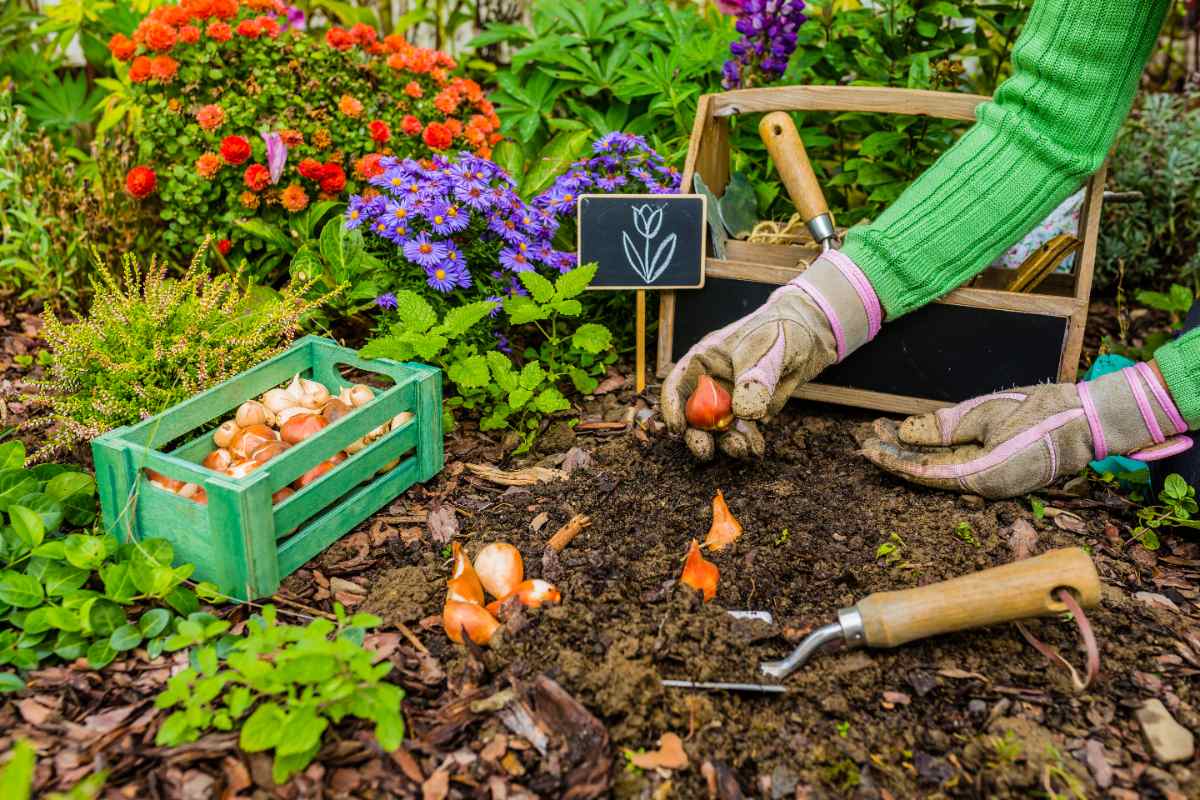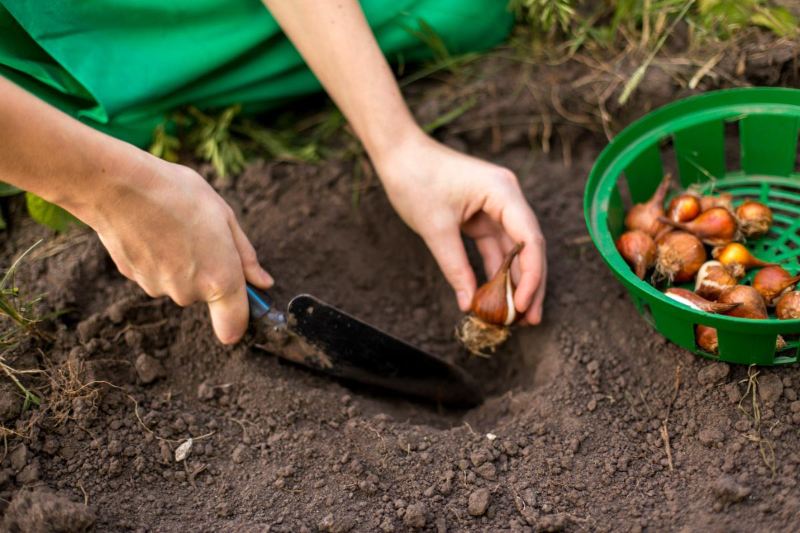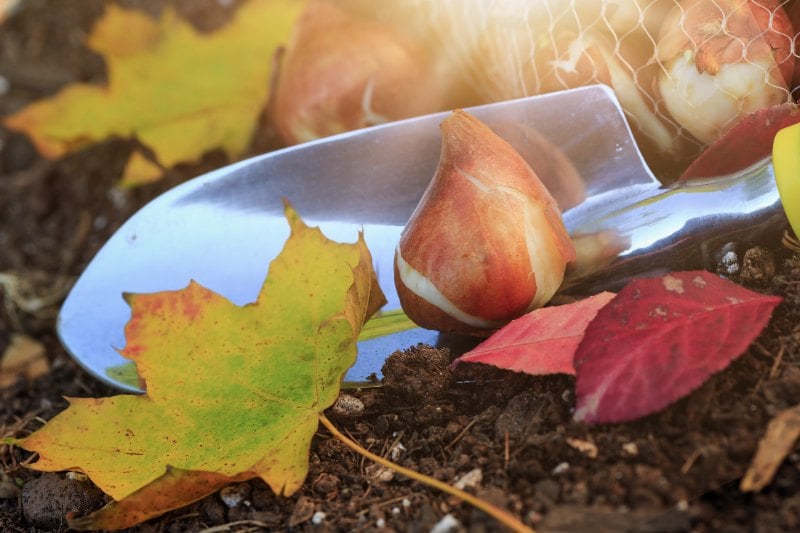
Knowing when to plant bulbs in fall can greatly increase the odds of beautiful blooms in spring. In northern regions, the best time is from September to early October. For southern states, it’s late October through December.
An expert will help explain this in more detail, so you can determine the best time to plant your fall bulbs. But if you’re overwhelmed with this information, you can always hire a local landscaping pro who knows exactly when to plant flower bulbs in your area.
Optimal Planting Times by Region
You’ve probably noticed more bulbs at local garden centers in recent years. According to Cognitive Market Research, U.S. imports of flower bulbs increased by 21.7% from 2021 to 2025, from $787 million to $958 million. So, why not try planting some in your own yard this fall? You just need to know how to plant bulbs and the right time to do it.
Here’s when to plant bulbs in the fall, depending on the region:
| Region | Best Time to Plant Bulbs in Fall |
| Northern regions (USDA zones 3-5) | September to early October |
| Transitional regions (USDA zones 6-7) | October to early November |
| Southern regions (USDA zones 8-10) | Late October through December |
Northern zones: In colder climates, bulbs must establish roots before the ground freezes. Planting in September through early October gives them 6 to 8 weeks to settle in.
Transitional zones: In these intermediate climates, the planting window shifts slightly later, so October into early November is ideal before consistent cold sets in.
Southern zones: In warmer regions, plant fall bulbs after the summer heat has passed, which is typically late October through December.
See Related: 10 Best Bulbs to Plant in Fall
Why Timing Matters for Bulb Success

“Many of the spring-blooming bulbs need to go through a cold period of 10 to 13 weeks to bloom in the spring,” says Nicole Flowers-Kimmerle, horticulture educator at the University of Illinois Extension.
“They (bulbs) also need time to put down roots in the fall to become established for spring blooms,” she says. So, remember the “6-week rule”:
| Bulbs should be in the ground for at least 6 weeks before the ground freezes so they can develop healthy roots. |
If planted too early, bulbs may sprout prematurely and rot. And when planted too late, bulbs may not develop a healthy root system.
Soil Temperature Guidelines
Planting flower bulbs in warm soil can cause them to produce foliage in the fall instead of flowers in the spring. So, rather than relying solely on calendar dates, soil temperature offers another reliable way to tell when your bulbs are ready to go in.
Here are a few guidelines:
- Aim for a soil temperature of 50 F to 60 F at bulb depth.
- Use a simple soil or meat thermometer to check the temperature at planting depth, typically 4 to 6 inches.
- Don’t plant when the soil is soggy or wet.
Early vs. Late Fall Planting
Flowers-Kimmerle says that bulbs won’t have enough energy to survive the winter when they’re planted too early. “If you wait until it’s cooler, most of the energy will go to creating roots, helping the plant to gather water and nutrients for the spring bloom.”
Here’s a quick comparison:
| Feature | Early Planting | Late Planting |
| Root development | More time for strong roots | Limited root growth before colder weather |
| Risk of rotting | Less, since the soil is drier and warmer | Higher, if the soil stays wet and cold |
| Cold hardiness | Bulbs acclimate slowly | May be shocked by the abrupt cold |
| Flexibility | More margin for delays | Less buffer, must hit the window |
Container vs. In-Ground Timing
“If you want a temporary seasonal display, containers work well,” says Flowers-Kimmerle. “You can layer the bulbs in a container to get a long season of blooms.” But if you’re looking for a more naturalized look, she says that in-ground is a good option.
However, timing shifts slightly when planting bulbs in pots instead of in-ground or in raised garden beds.
| Method | Best Planting Window | Notes |
| Containers | Slightly later than in-ground | Containers warm and cool faster, so delays reduce overheating or premature sprouting |
| In-ground | Follow the regional schedule | Bulbs benefit from natural insulation and ground moisture |
When planting in containers, we recommend waiting a bit later because pots heat up in the sun and can push bulbs to sprout earlier than they should. Also, remember that container bulbs may need extra insulation, such as mulch or frost covers, once winter sets in.
See Related:
Special Timing for Specific Bulbs

The following bulbs call for special timing:
- Tulips and hyacinths: Plant these bulbs in the earlier part of your window so they get a full chilling period.
- Daffodils and crocuses: You can plant these bulbs later in the window as long as the soil isn’t frozen yet.
- Alliums and lilies: Avoid planting them too early in very dry soil. Wait until moderate moisture returns.
- Other tender bulbs: Ranunculus and anemone are good examples of tender bulbs that may need planting right before frost if in colder regions.
If you don’t want to wait until spring to enjoy the beauty of flower bulbs, you can force them into blooming early and indoors. One way is to buy pre-chilled bulbs from garden centers. Tulips, daffodils, hyacinths, and crocuses are commonly used for indoor blooming from November to April.
You can also chill the bulbs yourself by placing them in the fridge at 40 F to 45 F for 12 to 15 weeks. Remember to keep them away from ripening fruits that release ethylene gas, as it can inhibit plant growth and flowering.
FAQ About When to Plant Bulbs in Fall
Yes, you can still plant bulbs in the spring if you miss the fall planting window. But instead of planting spring-flowering bulbs (like tulips and hyacinths), it’s better to plant summer-flowering bulbs (like dahlias and gladiolus).
Bulbs can tolerate a bit of wiggle room, but planting too early or too late increases the risk of poor growth in spring.
If your area doesn’t get hard freezes, you can still plant bulbs, as long as the soil temperature goes down to 40 F to 50 F in the winter.
Use Optimal Timing When Planting Bulbs
Plant bulbs at the right time, and they’ll reward you with stronger roots and brighter blooms. But if you’re not confident planting the bulbs yourself, hire a local landscaping pro who knows the best time to plant bulbs in your region.
Sources:
- “Autumn Time to Plant Spring Flowering Bulbs.” By Rosie Lerner, consumer horticulture Extension specialist. Purdue University.
- “Bulbs to Plant in the Fall.” By Kristine Lang, assistant professor. South Dakota State University Extension.
- “Forcing Bulbs for Indoor Bloom.” By David Trinklein, Extension state specialist. University of Missouri.
- Nicole Flowers-Kimmerle, horticulture educator at the University of Illinois Extension. Personal interview.
- “Plant Bulbs in the Fall for a Spring Celebration.” By Peter Ekstam, master gardener. PennState Extension.
- “Plant Bulbs Now for Spring Color.” By Lisa Johnson, Extension educator. University of Wisconsin Extension.
- “The Global Flower Bulb Market Report 2025 (Global Edition).” Cognitive Market Research.
Main Image: Gardener planting flower bulbs in soil. Image Credit: iMarzi / Adobe Stock